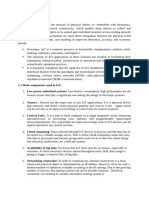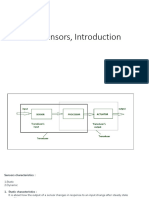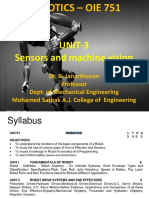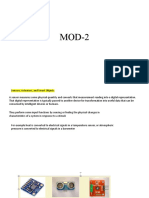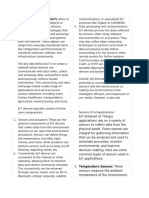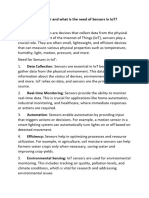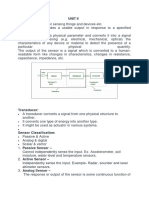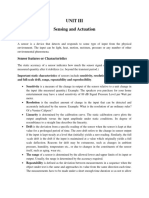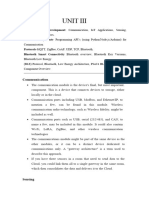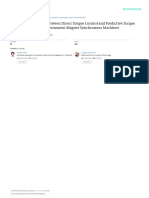0 ratings0% found this document useful (0 votes)
10 viewsIoT Module 2 IoT Sensing and Actuation
IoT Module 2 IoT Sensing and Actuation
Uploaded by
abhishek.ecThe document discusses sensors and sensing in IoT applications. It covers the basic concepts of transduction and differences between sensors, transducers and actuators. It also describes different types of sensors based on their power requirements, output and measured properties and discusses considerations for choosing sensors in IoT.
Copyright:
© All Rights Reserved
Available Formats
Download as PDF, TXT or read online from Scribd
IoT Module 2 IoT Sensing and Actuation
IoT Module 2 IoT Sensing and Actuation
Uploaded by
abhishek.ec0 ratings0% found this document useful (0 votes)
10 views25 pagesThe document discusses sensors and sensing in IoT applications. It covers the basic concepts of transduction and differences between sensors, transducers and actuators. It also describes different types of sensors based on their power requirements, output and measured properties and discusses considerations for choosing sensors in IoT.
Copyright
© © All Rights Reserved
Available Formats
PDF, TXT or read online from Scribd
Share this document
Did you find this document useful?
Is this content inappropriate?
The document discusses sensors and sensing in IoT applications. It covers the basic concepts of transduction and differences between sensors, transducers and actuators. It also describes different types of sensors based on their power requirements, output and measured properties and discusses considerations for choosing sensors in IoT.
Copyright:
© All Rights Reserved
Available Formats
Download as PDF, TXT or read online from Scribd
Download as pdf or txt
0 ratings0% found this document useful (0 votes)
10 views25 pagesIoT Module 2 IoT Sensing and Actuation
IoT Module 2 IoT Sensing and Actuation
Uploaded by
abhishek.ecThe document discusses sensors and sensing in IoT applications. It covers the basic concepts of transduction and differences between sensors, transducers and actuators. It also describes different types of sensors based on their power requirements, output and measured properties and discusses considerations for choosing sensors in IoT.
Copyright:
© All Rights Reserved
Available Formats
Download as PDF, TXT or read online from Scribd
Download as pdf or txt
You are on page 1of 25
* A major chunk of IoT applications involves sensing in one
form or the other.
* Almost all the applications in IoT, sensing forms the first
step.
* Actuation forms the final step in the whole operation of
IoT application deployment in a majority of scenarios.
* The basic science of sensing and actuation is based on
the process of transduction. Transduction is the process
of energy conversion from one form to another.
* Sensors and actuators are deemed as transducers.
Differences between transducers, sensors, and actuators
Sensors:
* Sensorsare devices that can measure, or quantify, or
respond to the ambient changes (exernal stimuli) in
their environment or within the intended zone of their
deployment. Heat, Humidity..
* A sensor is only sensitive to the measured property.
* A sensor does not influence the measured property.
Simple sensing operation
Sensor Classification:
1) power requirements, 2) sensor output, and 3) property
to be measured.
1. Power Requirements: The way sensors operate decides
the power requirements that must be provided for an
IoT implementation.
i. Active: Active sensors do not require an external
circuitry or mechanism to provide it with power.
It directly responds to the external stimuli from
its ambient environment and converts it into an
output signal. Ex. Photodiode
ii. Passive: Passive sensors require an external
mechanism to power them up. The sensed
properties are modulated with the sensor’s
inherent characteristics to generate patterns in
the output of the sensor. Ex. Thermistor, RFID
2. Output: The output of a sensor helps in deciding the
additional components to be integrated with an IoT
node or system
i. Analog: Analog sensors generate an output signal
or voltage, which is proportional (linearly or non-
linearly) to the quantity being measured and is
continuous in time and amplitude. Physical
quantities such as temperature, speed, pressure,
displacement, strain, and others are all
continuous and categorized as analog quantities.
Ex. thermometer
i. Digital: These sensors generate the output of
discrete time digital representation (time, or
amplitude, or both) of a quantity being
measured, in the form of output signals or
voltages. logic 1 or a logic 0 for ON or OFF.
3. Measured Property: The property of the environment being
measured by the sensors can be crucial in deciding the
number of sensors in an IoT implementation. Some
properties to be measured do not show high spatial
variations and can be quantified only based on temporal
variations like ambient temperature, atmospheric pressure,
some properties to be measured show high spatial as well as
temporal variations like sound, image.
i. Scalar: Scalar sensors produce an output proportional
to the magnitude of the quantity being measured. The
output is in the form of a signal or voltage. Scalar
physical quantities are those where only the magnitude
of the signal is sufficient for describing or
characterizing the phenomenon and information
generation. changes in sensor orientation or direction
do not affect these sensors
colour, pressure, temperature, strain
ii. Vector: Vector sensors are affected by the magnitude
as well as the direction and/or orientation of the
property they are measuring.
Ex. Electronic gyroscope
Sensor node in IoT
Sensor Characteristics:
Sensor of same type and class can be characterized by
their ability to sense the phenomenon based on the
following three fundamental properties.
i. Sensor Resolution: The smallest change in the
measurable quantity that a sensor can detect is
referred to as the resolution of a sensor. A sensor’s
accuracy does not depend upon its resolution. 0.5◦C
change in temp and 0.25◦C change in temp.
ii. Sensor Accuracy: The accuracy of a sensor is the ability
of that sensor to measure the environment of a system
as close to its true measure as possible. 100kg is
measured as 99.98kg.
iii. Sensor Precision: The principle of repeatability governs
the precision of a sensor. Only if, upon multiple
repetitions, the sensor is found to have the same error
rate, can it be deemed as highly precise.
Sensorial Deviations:
Most of the sensing in IoT is non-critical, where minor
deviations in sensorial outputs some times change the nature
of the undertaken tasks. However, some critical applications of
IoT, such as healthcare, industrial process monitoring, and
others, do require sensors with high-quality measurement
capabilities.
In the event of a sensor’s output signal going beyond its
designed maximum and minimum capacity for measurement,
the sensor output is truncated to its maximum or minimum
value, which is also the sensor’s limits.
Under real conditions, the sensitivity of a sensor may differ
from the value specified for that sensor leading to sensitivity
error.
If the output of a sensor differs from the actual value to be
measured by a constant, the sensor is said to have an offset
error or bias. 0 C is shown as 1.1 C.
Some sensors have a non-linear behavior. The amount a sensor’s
actual output differs from the ideal transfer function behavior
over the full range of the sensor quantifies its behavior. It is
denoted as the percentage of the sensor’s full range.
If the output signal of a sensor changes slowly and
independently of the measured property, this behavior of the
sensor’s output is termed as drift.
In contrast, if a sensor’s output varies/deviates due to
deviations in the sensor’s previous input values, it is referred to
as hysteresis error.
If the digital output of a sensor is an approximation of the
measured property, it induces quantization error.
Dynamic errors caused due to mishandling of sampling
frequencies can give rise to aliasing errors.
Finally, the environment itself plays a crucial role in inducing
sensorial deviations. Some sensors may be prone to external
influences, which may not be directly linked to the property
being measured by the sensor.
Sensing Types:
Sensing can be broadly divided into four different
categories based on the nature of the environment being
sensed and the physical sensors being used.
i. Scalar sensing: sensing of features that can be quantified
simply by measuring changes in the amplitude of the
measured values with respect to time.
Ambient temperature, current, atmospheric pressure,
rainfall, light etc.
ii. Multimedia sensing: sensing of features that have a spatial
variance property associated with the property of temporal
variance. Unlike scalar sensors,multimedia sensors are used
for capturing the changes in amplitude of a quantifiable
property concerning space (spatial) as well as time
(temporal).
Images, direction, flow, speed, acceleration, sound
iii. Hybrid sensing: The act of using scalar as well as
multimedia sensing at the same time is referred to
as hybrid sensing.
Plant health monitoring by measuring soil moisture,
temperature and camera. Smart parking system, traffic
management system etc.
iv. Virtual sensing: Many a time, there is a need for very
dense and large-scale deployment of sensor nodes
spread over a large area for monitoring of
parameters.
Advising farmer B by the use of sensors deployed in
farmer A’s field.
Sensing Considerations:
The choice of sensors in an IoT sensor node is critical and can
either make or break the feasibility of an IoT deployment.
The following major factors influence the choice of
sensors in IoT-based sensing solutions: 1) sensing range, 2)
accuracy and precision, 3)
energy, and 4) device size.
i. Sensing Range:The sensing range of a sensor node defines
the detection fidelity of that node. A lifelong fixed k-
coverage tends to usher in redundancy as it requires a large
number of sensor nodes, the sensing range of some of which
may also overlap. In contrast, dynamic kcoverage
incorporates mobile sensor nodes post detection of an
event, which, however, is a costly solution and may not be
deployable in all operational areas and terrains.
the sensing range of a sensor may also be used to signify
the upper and lower bounds of a sensor’s measurement
range.
Proximity sensor, camera
ii. Accuracy and Precision:The accuracy and precision
of measurements provided by a sensor are critical in
deciding the operations of specific functional
processes.
Off-the-shelf consumer sensors are low on requirements
and often very cheap. Their performance is limited to
regular application domains, but it is not suitable for
industrial processes.
Industrial sensors are typically very sophisticated, and as
a result, very costly, these industrial sensors have very
high accuracy and precision score, even under harsh
operating conditions.
Energy: The energy consumed by a sensing solution is
crucial to determine the lifetime of that solution and the
estimated cost of its deployment. If the sensor or the
sensor node is so energy inefficient that it requires
renewal of its energy sources quite frequently, the effort
in maintaining the solution and its cost goes up; whereas
its deployment feasibility goes down.
Sensor nodes deployed on the top of glaciers
Device Size: Modern-day IoT applications have a wide
penetration in all domains of life. Most of the applications
of IoT require sensing solutions which are so small that
they do not hinder any of the regular activities that were
possible before the sensor node deployment was carried
out. The wearable sensors are highly energy-efficient,
small in size
Actuators:An actuator can be considered as a machine or
system’s component that can affect the movement or
control the said mechanism or the system.
The system activates the actuator through a control
signal, which may be digital or analog. It draws response
from the actuator, which is in the form of some form of
mechanical motion.
Simple actuation mechanism
Actuator Types:actuators can be divided into seven
classes: 1) Hydraulic, 2) pneumatic, 3)electrical,
4) thermal/magnetic, 5) mechanical, 6) soft, and
7) shape memory polymers.
i. Hydraulic actuators: A hydraulic actuator works on
the principle of compression and decompression of
fluids. The mechanical motion applied to a hydraulic
actuator is converted to either linear, rotary, or
oscillatory motion. These hydraulic actuators are also
considered as stiff systems. The actuator’s limited
acceleration restricts its usage.
ii. Pneumatic actuators: A pneumatic actuator works
on the principle of compression and decompression
of gases. These actuators use a vacuum or
compressed air at high pressure and convert it into
either linear or rotary motion. They have quick
response to starting and stopping signals.
Pneumatic brakes
iii. Electric actuators: Mostly electric motors are used
to power an electric actuator by generating
mechanical torque. This class of actuators is
considered one of the cheapest, cleanest and speedy
actuator
Solenoid valves control the flow of water in pipes
in response to electrical signals
iv. Thermal or magnetic actuators: Thermal or
magnetic energy is used for powering this class of
actuators. These actuators have a very high power
density and are typically compact, lightweight, and
economical.
Classic example of thermal actuators is shape
memory materials (SMMs) such as shape memory alloys
(SMAs) & Magnetic shape memory alloys (MSMAs).
v. Mechanical actuators: In mechanical actuation, the
rotary motion of the actuator is converted into linear
motion to execute some movement. The use of
gears, rails, pulleys, chains, and other devices are
necessary for these actuators to operate. These
actuators can be easily used in conjunction with
pneumatic, hydraulic, or electrical actuators.
vi. Soft actuators: Soft actuators (e.g., polymer-based)
consists of elastomeric polymers that are used as
embedded fixtures in flexible materials such as
cloth, paper, fiber, particles, and others. The
conversion of molecular level microscopic changes
into tangible macroscopic deformations is the
primary working principle of this class of actuators.
vii.Shape memory polymers: Shape memory polymers
(SMP) are considered as smart materials that
respond to some external stimulus by changing their
shape, and then revert to their original shape once
the affecting stimulus is removed. Features such as
high strain recovery, biocompatibility, low density,
and biodegradability characterize these materials.
Photopolymer/light-activated polymers (LAP)
Actuator Characteristics: The choice or selection of actuators
is crucial in an IoT deployment, where a control mechanism is
required after sensing and processing of the information
obtained from the sensed environment. The correct choice of
actuators is necessary for the long-term sustenance and
continuity of operations, as well as for increasing the lifetime
of the actuators themselves.
i. Weight: The physical weight of actuators limits its
application scope. heavier actuators is generally preferred
for industrial applications and applications requiring no
mobility, lightweight actuators typically find common
usage in portable systems in vehicles, drones, and home
IoT applications.
ii. Power Rating: The power rating defines the minimum and
maximum operating power an actuator can safely
withstand without damage to itself. Smaller servo motors
used in hobby projects typically have a maximum rating of
5 VDC, 500 mA, Servo motors in larger applications have a
rating of 460 VAC, 2.5 A
iii. Torque to Weight Ratio: The ratio of torque to the
weight of the moving part of an instrument/device is
referred to as its torque/weight ratio. This indicates
the sensitivity of the actuator. Higher is the weight
of the moving part; lower will be its torque to weight
ratio for a given power.
iv. Stiffness and Compliance: The resistance of a
material against deformation is known as its
stiffness. Stiff systems are considered more accurate
than compliant systems as they have a faster
response to the change in load applied to it.
Hydraulic systems are considered as stiff and non-
compliant, whereas pneumatic systems are considered as
compliant.
You might also like
- PDF Semiconductor Optoelectronic Devices (2nd Edition) PDF Full by Pallab BhattacharyaDocument1 pagePDF Semiconductor Optoelectronic Devices (2nd Edition) PDF Full by Pallab BhattacharyaMeghnad-Marcus Tresscothick GhoshNo ratings yet
- Iot Module 2Document12 pagesIot Module 2nagaraj pNo ratings yet
- Module 2Document32 pagesModule 2rakshtha.ramesh32No ratings yet
- Iot Module 1 MaterialDocument30 pagesIot Module 1 Materialteswart2002No ratings yet
- IoT SensorsDocument15 pagesIoT Sensorsbikash20ugNo ratings yet
- IoT Sensing and Actuation - M2 - CompleteDocument59 pagesIoT Sensing and Actuation - M2 - Completesntsjnts7No ratings yet
- Internet of Things BETCK105H - Module - 2Document53 pagesInternet of Things BETCK105H - Module - 2Chandrashekhar BannikoduNo ratings yet
- MOdule 2 - GivenDocument58 pagesMOdule 2 - Givensreeni 1005No ratings yet
- Ahmed A Iot2Document24 pagesAhmed A Iot2Kavita KamerikarNo ratings yet
- Robotics Unit3 SensorsDocument120 pagesRobotics Unit3 SensorsJanarthanan BalakrishnasamyNo ratings yet
- 402C Unit - 2 IoTDocument26 pages402C Unit - 2 IoTsatheeshNo ratings yet
- CO2 NotesDocument71 pagesCO2 NotesShabbir AliNo ratings yet
- It 7sem Unit Ii IotDocument10 pagesIt 7sem Unit Ii IotMaitrayee SuleNo ratings yet
- Internet of Things-Unit 1Document21 pagesInternet of Things-Unit 1jayalakshmi.mca staffNo ratings yet
- Unit-3 SensorsDocument40 pagesUnit-3 Sensorsmubin.pathan765No ratings yet
- E-Note 5596 Content Document 20231104101220PMDocument16 pagesE-Note 5596 Content Document 20231104101220PMdigitalpixelpalleteNo ratings yet
- 5-Module 3 - Introduction To Sensors and Transducers-16!08!2024Document41 pages5-Module 3 - Introduction To Sensors and Transducers-16!08!2024Ekansh BhardwajNo ratings yet
- UNIT 5 Notes (BOE305)Document16 pagesUNIT 5 Notes (BOE305)vanshsri003No ratings yet
- IoT-Lecture-4. SlidesDocument22 pagesIoT-Lecture-4. SlidesPrithviraj ChiripalNo ratings yet
- Topic:: Sensor TechnologyDocument15 pagesTopic:: Sensor TechnologyPooja koreNo ratings yet
- IOT Notes Unit-1Document37 pagesIOT Notes Unit-1laptopuser197No ratings yet
- M-2 (IoT) 1st SemDocument16 pagesM-2 (IoT) 1st SemBhargav SahNo ratings yet
- IoT. Lecture 2. Sensors Introduction and IMUDocument27 pagesIoT. Lecture 2. Sensors Introduction and IMU3142588563No ratings yet
- Robotic SensorsDocument43 pagesRobotic SensorsArivukkarasan RajaNo ratings yet
- Internet of Things 2Document54 pagesInternet of Things 2R G SakthivelanNo ratings yet
- Sensors PPT NotesDocument23 pagesSensors PPT NotesUday sonwaneNo ratings yet
- U1-Intraduction To Sensors and TransducersDocument74 pagesU1-Intraduction To Sensors and TransducersVibishiniya VNo ratings yet
- Sensors A Comprehensive GuideDocument10 pagesSensors A Comprehensive Guidemanoj NNo ratings yet
- Module 2 IoTDocument11 pagesModule 2 IoTK Goutam XII 'D'No ratings yet
- Unit - 3 Iot and ApplicationsDocument23 pagesUnit - 3 Iot and Applicationssaidinesh.garudaNo ratings yet
- Mod 2Document51 pagesMod 2Paramita MitraNo ratings yet
- Internet of Things Unit1Document17 pagesInternet of Things Unit1meganathanNo ratings yet
- MODULE 2 (1)Document35 pagesMODULE 2 (1)丂卂Ҝ丂卄卂ㄒ卄No ratings yet
- Unit-2 Week-1Document37 pagesUnit-2 Week-1vomyNo ratings yet
- Unit 2 Iot 7 SemDocument56 pagesUnit 2 Iot 7 Semapoorvasainimitrc2020No ratings yet
- Unit II: 1. Define SensorsDocument5 pagesUnit II: 1. Define Sensorspatelrohit7063No ratings yet
- CHAPTER 1 sensorDocument7 pagesCHAPTER 1 sensor35zazaoozaNo ratings yet
- shivpratap singhDocument18 pagesshivpratap singhMansi VermaNo ratings yet
- Unit-I Introduction to SensorsDocument7 pagesUnit-I Introduction to SensorsNilesh SableNo ratings yet
- Unit 1 (QB Iot)Document10 pagesUnit 1 (QB Iot)ADITYA SACHIN NEVENo ratings yet
- Types of Sensors and Their ApplicationsDocument5 pagesTypes of Sensors and Their ApplicationsSaurabh RajputNo ratings yet
- VMKV Engineering College, Salem Aeronautical Engineering CourseDocument32 pagesVMKV Engineering College, Salem Aeronautical Engineering CourseGaurav MullickNo ratings yet
- Sensors, ClassificationDocument5 pagesSensors, ClassificationPooja kNo ratings yet
- MOUNIMAPPTDocument23 pagesMOUNIMAPPTbudigibmounimaNo ratings yet
- SensortechnologyDocument2 pagesSensortechnologyMAULIK MORADIYANo ratings yet
- Sensor Classification and How To Choose A SensorDocument7 pagesSensor Classification and How To Choose A SensorAkhilesh Reddy KarraNo ratings yet
- Unit2-1 Intelligent SensorsDocument32 pagesUnit2-1 Intelligent Sensorskavya kavNo ratings yet
- SensorDocument16 pagesSensorTaha AzaddNo ratings yet
- Sensor and ActuatorDocument42 pagesSensor and ActuatorArief IskandarNo ratings yet
- Unit IiiDocument11 pagesUnit IiiCbitpavan ReddyNo ratings yet
- Internet of Things - CHP 2-2Document14 pagesInternet of Things - CHP 2-2rohanoza1450No ratings yet
- IoT Unit 3Document50 pagesIoT Unit 3lovelynani792No ratings yet
- Syllabus of BeeeDocument9 pagesSyllabus of BeeeMr. Kishore Ajay Kumar AyyalaNo ratings yet
- L - 5 Sensors and Transforms by Arpita MemDocument31 pagesL - 5 Sensors and Transforms by Arpita MemAbul Hasan 2No ratings yet
- Chapter-5 Module 2-IoT For Ist SemDocument48 pagesChapter-5 Module 2-IoT For Ist SemNeha nayak100% (3)
- Sensors in Internet of ThingsDocument5 pagesSensors in Internet of ThingsAnkshu RayNo ratings yet
- IoT - Module 3Document19 pagesIoT - Module 3bhargaviNo ratings yet
- IOT Exp-1.2Document13 pagesIOT Exp-1.2reripe9614No ratings yet
- OIE 751 ROBOTICS Unit 3 Class 1 (11-9-2020)Document13 pagesOIE 751 ROBOTICS Unit 3 Class 1 (11-9-2020)MICHEL RAJNo ratings yet
- Smart Sensors REPORT PDFDocument15 pagesSmart Sensors REPORT PDFZainkhalid828No ratings yet
- Industry Day - Code 70 Slides 2.25.14Document11 pagesIndustry Day - Code 70 Slides 2.25.14N TNo ratings yet
- Many Non-Reed-Solomon Type MDS Codes From Arbitrary Genus Algebraic Curves (Hao Chen)Document26 pagesMany Non-Reed-Solomon Type MDS Codes From Arbitrary Genus Algebraic Curves (Hao Chen)Marvin OlavidesNo ratings yet
- Problem Sheet On Markov ChainDocument5 pagesProblem Sheet On Markov Chain21bit026No ratings yet
- Example 5.3: A B C DDocument11 pagesExample 5.3: A B C DAisyah JamalNo ratings yet
- Battery Design Module Users GuideDocument720 pagesBattery Design Module Users GuidemarkoNo ratings yet
- Optical Scattering Measurements and Analysis Third Edition John C. Stover 2024 Scribd DownloadDocument82 pagesOptical Scattering Measurements and Analysis Third Edition John C. Stover 2024 Scribd Downloadfarihabedira100% (4)
- Particle in A BoxDocument14 pagesParticle in A BoxAman bansalNo ratings yet
- MATHS - 15th MAY PAIR OF LINEAR EQUATIONS - AssignmentDocument4 pagesMATHS - 15th MAY PAIR OF LINEAR EQUATIONS - AssignmentSai KrithikNo ratings yet
- Name of The Experiment: Study and Design of Different Types of Hand Tools (Pliers)Document9 pagesName of The Experiment: Study and Design of Different Types of Hand Tools (Pliers)KsdroyNo ratings yet
- Hydraulic Safety Interlock Manifold SystemsDocument34 pagesHydraulic Safety Interlock Manifold SystemsMauricioNo ratings yet
- MATM111Document5 pagesMATM111Ken CarlonNo ratings yet
- A Comparative Study Between Direct Torque ControlDocument9 pagesA Comparative Study Between Direct Torque Control1032212420No ratings yet
- Semester A, 2015-16 MA2177 Engineering Mathematics and StatisticsDocument40 pagesSemester A, 2015-16 MA2177 Engineering Mathematics and Statisticslee ronNo ratings yet
- Micromachines 06 01346 v2Document19 pagesMicromachines 06 01346 v2mezianeNo ratings yet
- CH 3Document39 pagesCH 3Hadis SyoumNo ratings yet
- (Cô Vũ Mai Phương) Đề Thi & Hướng Dẫn Giải Chi Tiết Đề Thi Tham Khảo Số 01 - Tháng 10Document22 pages(Cô Vũ Mai Phương) Đề Thi & Hướng Dẫn Giải Chi Tiết Đề Thi Tham Khảo Số 01 - Tháng 10Ngo Thi Thu Hang100% (1)
- Philosophy in A Week Teach Yourself 2013Document127 pagesPhilosophy in A Week Teach Yourself 2013millerlong987No ratings yet
- Physics Practice Final Exam Solutions PDFDocument11 pagesPhysics Practice Final Exam Solutions PDFDavid I. Chamorro AriasNo ratings yet
- Birla Institute of Technology and Science, Pilani Pilani CampusDocument5 pagesBirla Institute of Technology and Science, Pilani Pilani CampusRohit KumarNo ratings yet
- Mahajan DissertationDocument123 pagesMahajan DissertationhithereNo ratings yet
- Concept of Atomic Number Led To The SynthesisDocument52 pagesConcept of Atomic Number Led To The SynthesisGian Carlo Limpin100% (2)
- Nuclear Shell ModelDocument31 pagesNuclear Shell ModelANKIT DEVNo ratings yet
- Chapter 05 Electricity For LightingDocument41 pagesChapter 05 Electricity For LightingHeleana Faye BundocNo ratings yet
- D M DX EI: Deflection of Beams - NomenclatureDocument3 pagesD M DX EI: Deflection of Beams - Nomenclatureaap1No ratings yet
- High Ductility Aluminum Alloy Made From Powder by Friction ExtrusionDocument6 pagesHigh Ductility Aluminum Alloy Made From Powder by Friction ExtrusionRaistlin1No ratings yet
- برنامج الدراسات العليا - الجديد - 02Document24 pagesبرنامج الدراسات العليا - الجديد - 02Sulaiman AL MajdubNo ratings yet
- To Perform Signal Operations On Continuous Time and Discrete Time Signals Using MATLAB.Document16 pagesTo Perform Signal Operations On Continuous Time and Discrete Time Signals Using MATLAB.LUKESH ankamwarNo ratings yet
- Midterm Examination (SSP)Document6 pagesMidterm Examination (SSP)Precious Del mundoNo ratings yet
- Lesson 1 Historical Antecedents Which Changed The Course of Science and TechnologyDocument4 pagesLesson 1 Historical Antecedents Which Changed The Course of Science and TechnologyBloom rachNo ratings yet



